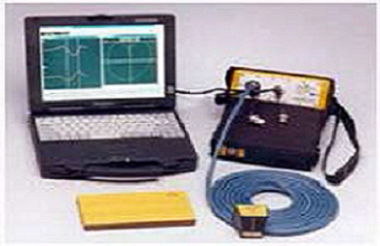Alternating Current Field Measurements:
ACFM is used for detecting and sizing surface breaking flaws.
ACFM is also applied to structures both in and out of the water.
(It has the advantage over some other techniques that the structure requires minimal cleaning and that it can be applied over paint and other coatings up to several millimeters in thickness).
ACFM is an electromagnetic technique.
A sensor probe is placed on the surface to be inspected and an alternating current is induced into the surface.
When no defects are present the alternating current produces a uniform magnetic field above the surface.
Any defect present will perturb the current, forcing it to flow around and underneath the defect;
this causes the magnetic field to become non-uniform and sensors in the ACFM probe measure these field variations.
Two components of this magnetic field are measured one provides information about the depth or aspect ratio of the defect(s), and the other shows the positions of the defects' ends. The two signals are used to confirm the presence of a defect and, together with a sizing algorithm, measure its length and depth.
ACFM is particularly suited to the detection and sizing of fatigue cracks at the toes of welds, including all butt, fillet, node and nozzle welds.
These have a paint coating so that ACFM was particularly suitable. In some cases, inspections are made to a routine schedule to determine whether crack growth is occurring. ACFM to inspect fillet welds in Mobile Offshore Drilling Units (MODUs) to detect any possible original fabrication hydrogen cracking present at weld toes. It has also been successfully deployed in the laboratory in a joint industry project to detect stress corrosion cracking in duplex stainless-steel pipe welds.
The main technical advantages of ACFM:
- The ability to detect defects through several millimeters of the coating.
- This means that paint or other protective coatings do not have to be removed and then reapplied.
- Works equally well on plain material or welds, ferritic or non-ferritic metals.
- Can be used on hot surfaces, underwater, or in irradiated environments.
- Provides both depth and length information.
- Defects up to 25mm (1") in depth can be sized accurately.
- All data is stored for backup, audit or review purposes.
- Simple scanning enabling 1 or 2 man operation including abseiler, diver and ROV deployed.
- The AMIGO Unit has almost no consumable costs.


